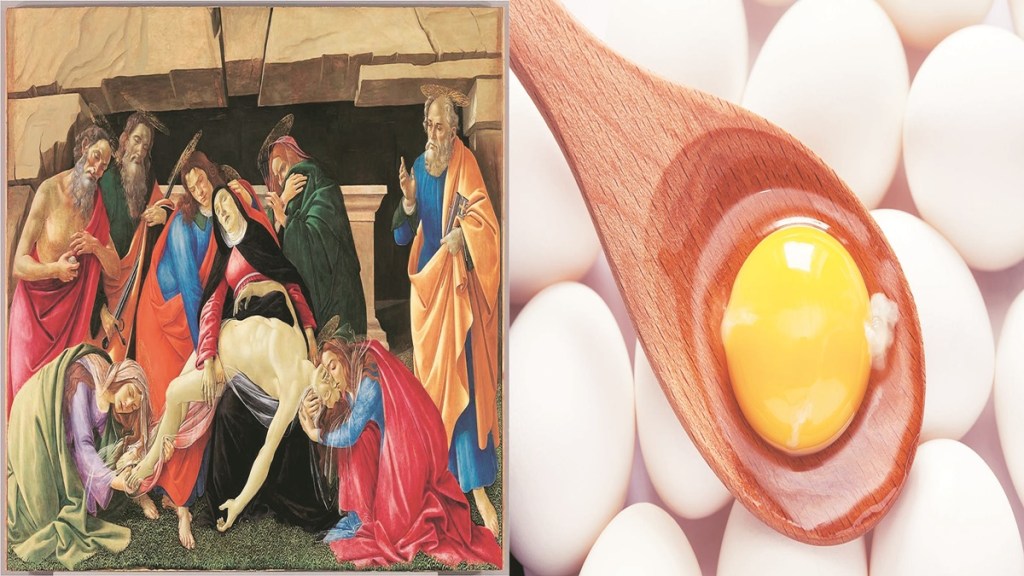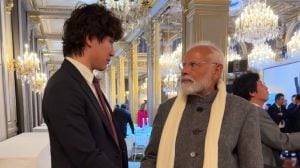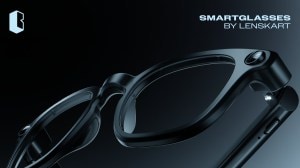Food is not just symbolically used in art for artistic rendition but can be used as an ingredient to paint as well. For instance, fruits have been a quintessential subject in the genre of still-life works from artists across the world through different eras. On the other hand, food ingredients are used for their natural pigments and binding purposes. If we look at some of the historic references of yesteryear artists, studies suggest that old masters, especially Italian painters of the Early Renaissance, like Sandro Botticelli, had used paints that contained mixtures of oils and proteins. Botticelli used both egg tempera and oil painting techniques in some of his paintings.
Egg tempera or tempera is a permanent, fast-drying painting medium consisting of coloured pigments mixed with a water-soluble binder medium, usually glutinous material such as egg yolk. The validation is a recent research published in Nature journal that provides a stunning portrayal of the use of egg in paintings of traditional Old Masters’ works containing oil as a binding medium, possibly with varying additions of some resins.
Traces of egg proteins have been detected in oil paints of Leonardo da Vinci and other Italian Renaissance masters and late medieval Cologne paintings, and those by German painter Albrecht Dürer, Dutch artists like Johannes Vermeer, Rembrandt and many others. Botticelli is said to have used mixtures of oils and proteins like an egg yolk as it acts as an antioxidant, slowing down the onset of curing. The combination of oil and egg helps to stop the painting from degrading, wrinkling, or yellowing, compared to oil alone, which might improve the preservation of invaluable artworks, explains the journal. Even in the Stone Age, cave painters used extenders like biotite and feldspar, vegetable juice, animal fats as binding ingredients in their paints.
“From ancient art to modern or contemporary paintings, art and food have had a long-standing relationship. As expressions of human creativity and culture, food and art have crossed paths in several ways, whether it is artists choosing food as their subject to create visually stunning works of art with food items as their subject or the use of these natural resources to aid in their artistic practice,” says Sunny Chandiramani, senior vice president, client relations, AstaGuru Auction House.
In India, artist Jamini Roy was considered one of the most important figures in the discourse of Modern Indian Art. His emergence came at a time of sea change in the landscape of cultural expression in Bengal. He gave up the medium of oil in favour of natural traditional pigments from vegetable and mineral sources and started to paint on different surfaces such as cloth, woven mats, and wood coated with lime. He also ferociously experimented with egg tempera and tamarind seed glue for binding purposes. In the early part of his career, his preferred choice of medium was watercolour. However, after he went through an artistic shift in the 1930s, he created the majority of his works in the medium of tempera along with use of natural pigments.
The colours found in food come from a variety of sources, including fruits, vegetables, spices, and insects. These pigments can be extracted and used to create paints, dyes, and other art materials. “These ingredients have been used as binders in mediums of visual art for centuries. A binder is a substance that holds other materials together, and it is an essential component of many different types of art. Some of the most common food ingredients used as binders in visual art include egg yolk, a traditional ingredient in tempera paint, which is also used to make watercolour paints more opaque. Gum Arabic, extracted from the sap of acacia trees, is used in a variety of art media, including watercolour, acrylic paints, and gouache — a painting technique in which a gum or an opaque white pigment is added to watercolours to produce opacity. Another natural food ingredient used in art is cornstarch,” adds Chandiramani.









